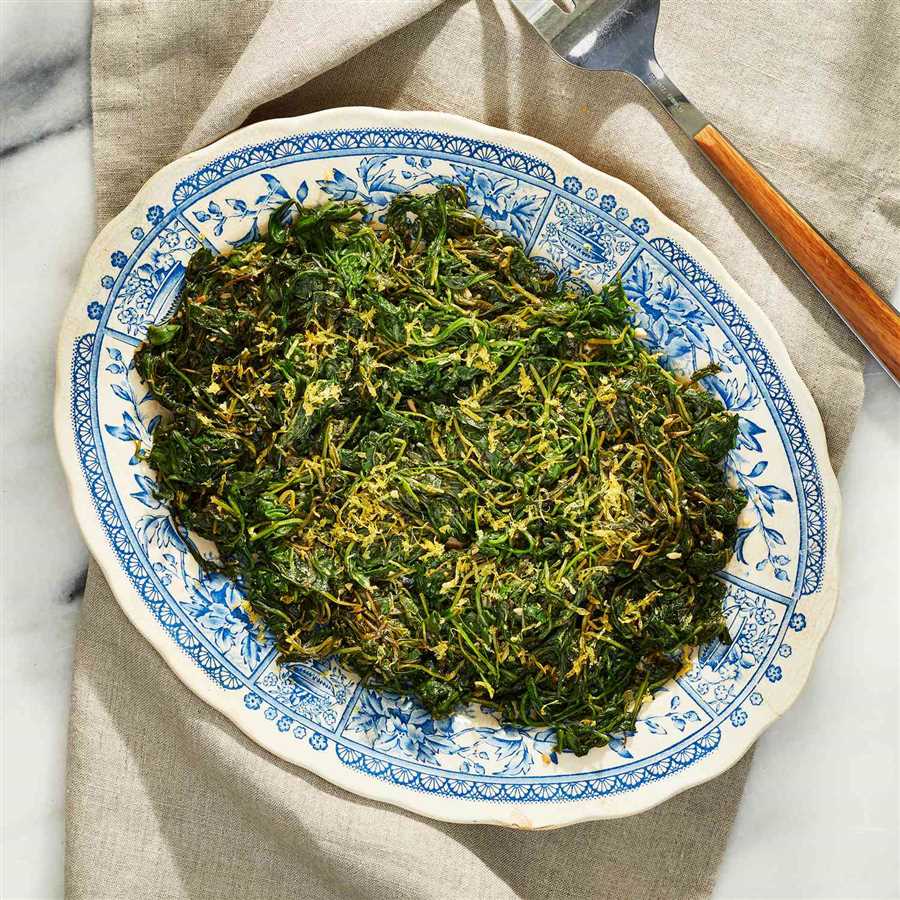





Arugula is a leafy green vegetable that is known for its peppery and slightly bitter taste. It is often used raw in salads or as a garnish, but can it be cooked like spinach?
While arugula is typically enjoyed raw, it can also be cooked and used in a variety of dishes. When cooked, arugula becomes milder in flavor and softer in texture, similar to spinach. This makes it a versatile ingredient that can be incorporated into cooked dishes such as pasta, soups, and stir-fries.
When cooking arugula, it is best to briefly sauté or steam it to preserve its vibrant green color and to prevent it from becoming too wilted. This will help retain its nutritional value and ensure that it remains crisp and tender.
Arugula can be a great substitute for spinach in recipes that call for cooked greens. Its distinct flavor adds a unique touch to dishes, while still providing a similar texture and nutritional profile to spinach.
So, the next time you’re looking to switch up your greens, don’t be afraid to give cooked arugula a try. It may just become your new favorite cooking ingredient!
Can Arugula Replace Spinach in Cooking?

Arugula is a leafy green vegetable that has gained popularity in recent years for its peppery and slightly bitter taste. While it may not be as commonly used in cooking as spinach, arugula can certainly be a delicious and nutritious substitute.
One of the main differences between arugula and spinach is their flavor profiles. Arugula has a more intense and spicy taste compared to the milder flavor of spinach. However, this can actually work in its favor when used in certain dishes.
Arugula can be used as a substitute for spinach in many different recipes, including salads, soups, stir-fries, and pasta dishes. Its distinct flavor can add a unique twist to these dishes and provide a refreshing change from the usual spinach taste.
It is important to note that arugula has a slightly tougher texture compared to spinach. This means that it may require a slightly longer cooking time when used in recipes that call for cooked spinach. However, arugula still retains its crispness when cooked, making it a versatile option for those looking to experiment with different leafy greens.
In terms of nutritional value, both arugula and spinach are packed with essential vitamins and minerals. Arugula is particularly rich in vitamin K and vitamin C, while spinach is a great source of iron and folate. By incorporating arugula into your cooking, you can enjoy the unique flavors and reap the health benefits that it has to offer.
In conclusion, arugula can indeed replace spinach in cooking. Its intense flavor and versatility make it a perfect substitute for those looking to switch things up in the kitchen. So the next time you’re in the mood for a leafy green, consider reaching for a bunch of arugula and give it a try!
Benefits of Arugula in Cooking
Arugula, also known as rocket or rucola, is a leafy green vegetable that is commonly used in salads and other dishes. It has a distinct peppery flavor that adds a unique taste to any recipe. However, arugula can also be cooked and used in a variety of ways, offering several benefits in cooking.
1. Versatility: Arugula can be used in a wide range of dishes, from pasta and risotto to sandwiches and pizzas. Its flavor pairs well with other ingredients and can add a fresh and vibrant touch to any meal.
2. Nutritional Value: Arugula is packed with essential vitamins and minerals, making it a healthy addition to your cooking. It is a great source of vitamin K, vitamin C, and folate, which are important nutrients for supporting overall health.
3. Flavor Enhancement: When cooked, the peppery flavor of arugula becomes milder, making it a great option for those who prefer a more subtle taste. It can be sautéed, steamed, or added to soups and stews to enhance the flavors of the dish.
4. Texture: Cooking arugula can change its texture, adding a softer and more tender element to your meals. This can be particularly beneficial when incorporating arugula into cooked dishes like pasta or grain bowls.
5. Color and Presentation: Cooked arugula can add vibrant green color to your dishes, making them visually appealing. It can be used as a garnish or mixed into other ingredients to make your meals look more appetizing.
In conclusion, arugula is a versatile ingredient that can be used in cooking in a variety of ways. It not only adds flavor and texture to your dishes but also brings numerous health benefits. So, next time you’re looking to experiment in the kitchen, consider cooking with arugula for a delightful addition to your meals.
How to Cook Arugula

Arugula, also known as rocket or rucola, is a versatile leafy green that can be enjoyed in salads or cooked as a side dish. Although it is most commonly consumed raw, arugula can also be cooked to create a delicious and nutritious addition to your meals.
Directions:
- Begin by washing the arugula thoroughly under cold water to remove any dirt or debris.
- Gently pat the arugula dry with a clean towel or use a salad spinner to remove excess water.
- Heat a skillet or frying pan over medium heat and add a small amount of olive oil or butter.
- Add the washed and dried arugula to the skillet and sauté for approximately 2-3 minutes until it begins to wilt.
- Season the arugula with salt, pepper, and any other desired herbs or spices.
- Cook for an additional minute, stirring occasionally, until the arugula is fully wilted and tender.
- Remove the cooked arugula from the heat and serve immediately.
Note: Cooking arugula can help to mellow out its slightly bitter taste and create a more subdued flavor. It pairs well with a wide range of ingredients, such as garlic, lemon, Parmesan cheese, or pine nuts, so feel free to experiment with different flavor combinations to suit your taste.
Benefits of Cooking Arugula:
While arugula is highly nutritious when consumed raw, cooking it can offer additional health benefits. Cooking arugula can help to break down its fibrous structure, making it easier for your body to absorb important nutrients like vitamins A, C, and K. Additionally, cooking arugula can help to soften its texture and make it more palatable for those who find the raw taste too intense.
Whether you prefer arugula raw or cooked, it is a delicious and nutritious addition to any meal. So go ahead and give cooking arugula a try to enjoy its unique flavors and health benefits!
Questions and answers
Is arugula like spinach?
Arugula and spinach are both leafy greens, but they have different flavors and textures. Arugula has a peppery taste, while spinach is more mild. Spinach also has a softer texture compared to the crunchy leaves of arugula.
Can arugula be used as a substitute for spinach in recipes?
Yes, arugula can be used as a substitute for spinach in certain recipes. However, it’s important to note that arugula has a stronger flavor, so it may alter the taste of the dish. Arugula is great in salads, sandwiches, and as a pizza topping, but it may not work as well in cooked dishes like soups or stir-fries.
Can arugula be cooked like spinach?
Yes, arugula can be cooked like spinach. You can sauté it in a pan with olive oil and garlic, or add it to soups and stews. Keep in mind that arugula cooks down much faster than spinach, so you’ll only need to cook it for a minute or two until it wilts. Overcooking arugula can cause it to become mushy and lose its flavor.
What are some ways to use cooked arugula?
There are various ways to use cooked arugula. You can mix it into pasta dishes, such as spaghetti or penne with arugula and Parmesan cheese. Cooked arugula also makes a delicious topping for pizzas and flatbreads. Additionally, you can incorporate it into omelettes or quiches, or use it as a filling for sandwiches and wraps. The possibilities are endless!






